NCERT Solutions for Class 12 Maths Chapter 13 Probability Ex 13.3
The topics and sub-topics included in Chapter 13 Probability the following:
| Section Name | Topic Name |
| 13 | Probability |
| 13.1 | Introduction |
| 13.2 | Conditional Probability |
| 13.3 | Multiplication Theorem on Probability |
| 13.4 | Independent Events |
| 13.5 | Bayes’ Theorem |
| 13.6 | Random Variables and its Probability Distributions |
| 13.7 | Bernoulli Trials and Binomial Distribution |
NCERT Solutions for Class 12 Maths Chapter 13 Probability 13.3 are part of NCERT Solutions for Class 12 Maths . Here we have given Class 12 Maths NCERT Solutions Probability Ex 13.3
Class 12 Maths Probability Solutions
- Probability Class 12 NCERT Solutions Ex 13.1
- Probability Class 12 NCERT Solutions Ex 13.2
- Probability Class 12 NCERT Solutions Ex 13.4
- Probability Class 12 NCERT Solutions Ex 13.5
Chapter 13 Probability Exercise 13.3
Question 1.
An urn contain 5 red and 5 black balls. A ball is drawn at random, its colour is noted and is returned to the urn. Moreover, 2 additional balls of the colour drawn are put in the urn and then a ball is drawn at random.What is the probability that the second ball is red?
Solution:
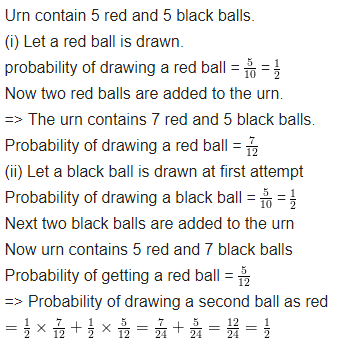
Question 2.
A bag contains 4 red and 4 black balls, another bag contains 2 red and 6 black balls. One of the two bags is selected at random and a ball is drawn from the bag which is found to be red. Find the probability that the ball is drawn from the first bag.
Solution:
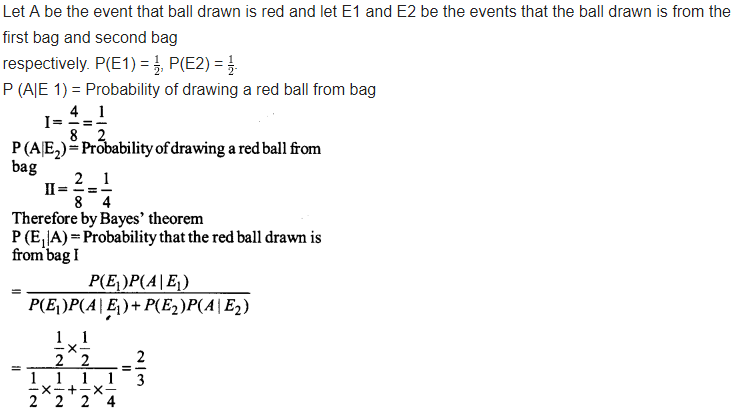
Question 3.
Of the students In a college, it is known that 60% reside In hostel and 40% are day scholars (not residing In hostel). Previous year results report that 30% of all students who reside in hostel attain A grade and 20% of day scholars attain A grade in their annual examination. At the end of the year, one student Is chosen at random from the college and he has an A- grade what Is the probability that the student is a hostlier?
Solution:
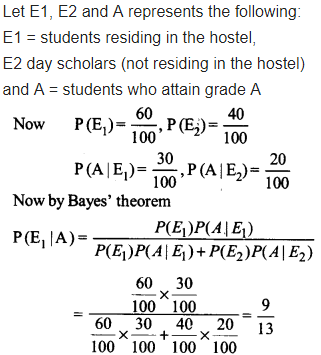
Question 4.
In answering a question on a multiple choice test, a student either knows the answer or 3 guesses. Let \(\frac { 3 }{ 4 }\) be the probability that he knows the answer and \(\frac { 1 }{ 4 }\) be the probability that he guesses. Assuming that a student who guesses at the answer will be correct with probability \(\frac { 1 }{ 4 }\) . What is the probability that the student knows the answer given that he answered it correctly?
Solution:
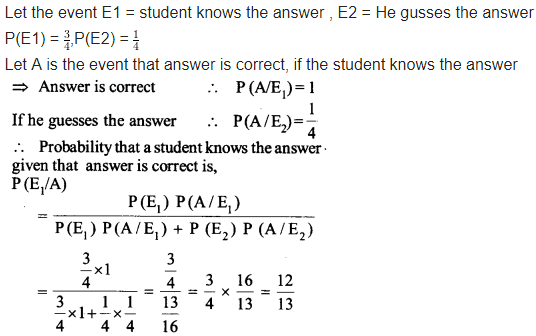
Question 5.
A laboratory blood test is 99% effective in detecting a certain disease when it is, in fact, present. However, the test also yields a false positive result for 0.5% of the healthy person tested (i.e. if a healthy person is tested, then, with probability 0.005, the test will imply he has the disease). If 0.1 percent of the population actually has the disease, what is the probability that a person has the disease given that his test result is positive?
Solution:
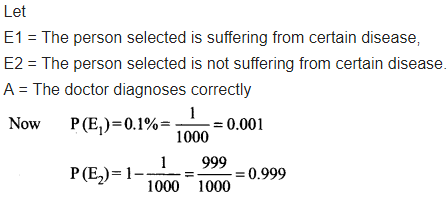
Question 6.
There are three coins. One is a two headed coin, another is a biased coin that conies up heads 75% of the time and third is an unbiased coin. One of the three coins is choosen at random and tossed, it shows head, what is the probability that it was the two headed coin?
Solution:
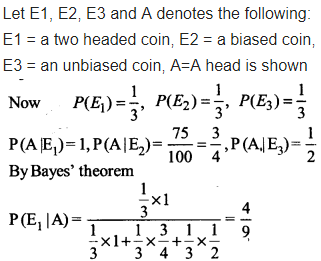
Question 7.
An insurance company insured 2000 scooter drivers, 4000 car drivers and 6000 truck drivers. The probability of mi accident are 0.01, 0.03, 0.15 respectively. One of the insured persons meets with an accident. What is the probability that he is a scooter driver?
Solution:
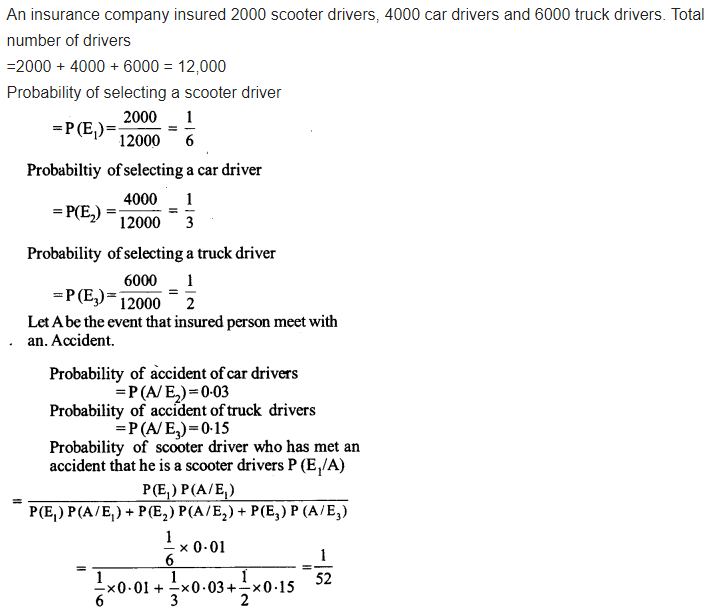
Question 8
A factory has two machines A and B. Past record shows that machine A produced 60% of the items of output and machine B produced 40% of the items. Further, 2% of the items produced by machine A and 1% produced by machine B were defective.All the items are put into one stockpile and then one item is chosen at random from this and is found to be defective. What is the probability that it was produced by machine B.?
Solution:

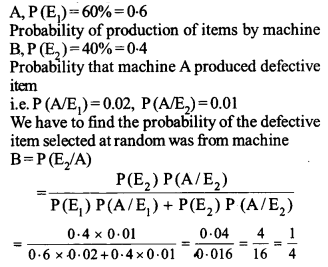
Question 9.
Two groups are competing for the position on the Board of directors of a corporation. The probabilities that the first and the second groups will win are 0.6 and 0.4 respectively. Further, if the first group wins, the probability of introducing a new product is 0.7 and the corresponding probability is 0.3 if the second group wins. Find the probability that the new product introduced was by the second group.
Solution:

Question 10.
Suppose a girl throws a die. If she gets a 5 or 6, she tosses a coin three times and notes the number of heads.If she gets 1,2,3 or 4, she tosses a coin once and notes whether a head or tail is obtained. If she obtained exactly one head, what is the probability that she threw 1,2,3, or 4 with the die?
Solution:
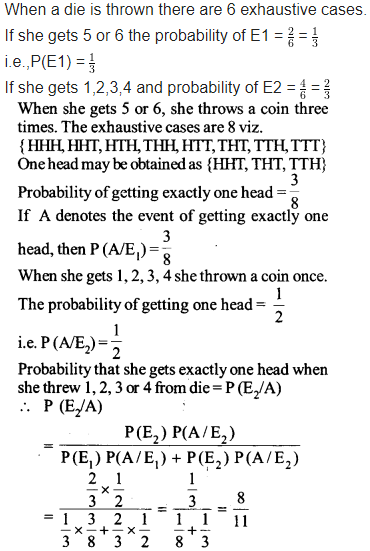
Question 11.
A manufacturer has three machine operators A, B and C. The first operator A produces 1% defective items, where as the other two operators B and C produce 5% and 7% defective items respectively. A is on the job for 50% of the time, B is on the job for 30% of the time and C is on the job for 20% of the time. A defective item is produced, what is the probability that it was produced by A?
Solution:
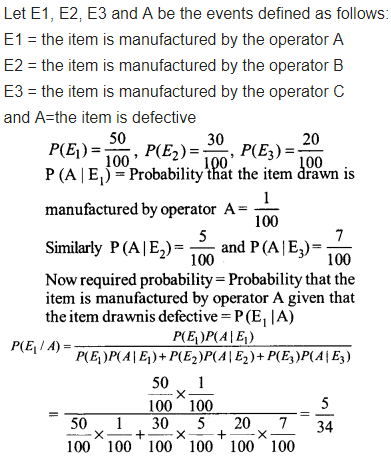
Question 12.
A card from a pack of 52 cards is lost From the remaining cards of the pack, two cards are drawn and are found to be both diamonds. Find the probability of the lost card being a diamond?
Solution:
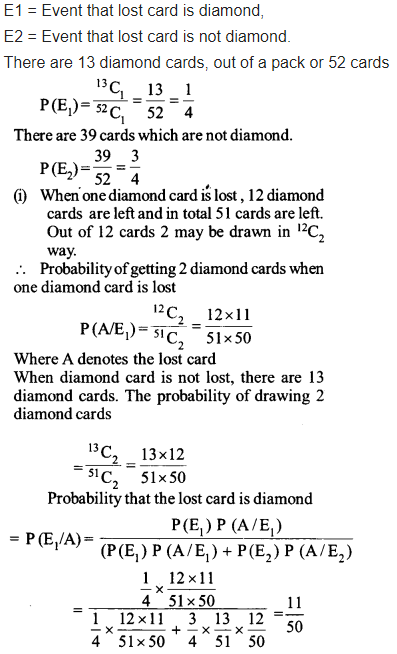
Question 13.
Probability that A speaks truth is 4/5. A coin is tossed. A reports that a head appears. The probability that actually there was head is
A. 4/5
B. 1/2
C.1/5
D.2/5

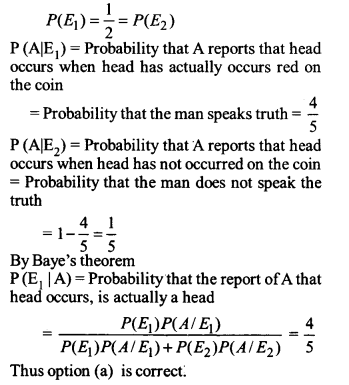
Question 14.
If A and B are two events such that A⊂B and P (B) ≠ 0, then which of the following is correct:
(a) P(A | B) = \(\frac { P(B) }{ P(A) }\)
(b) P (A | B) < P (A)
(c) P(A | B) ≥ P(A)
(d) None of these
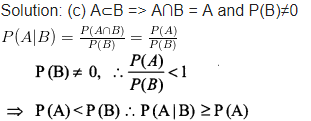
Class 12 Maths NCERT Solutions
- Chapter 1 Relations and Functions
- Chapter 2 Inverse Trigonometric Functions
- Chapter 3 Matrices
- Chapter 4 Determinants
- Chapter 5 Continuity and Differentiability
- Chapter 6 Application of Derivatives
- Chapter 7 Integrals Ex 7.1
- Chapter 8 Application of Integrals
- Chapter 9 Differential Equations
- Chapter 10 Vector Algebra
- Chapter 11 Three Dimensional Geometry
- Chapter 12 Linear Programming
- Chapter 13 Probability Ex 13.1